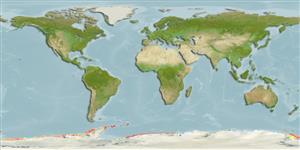Symplectoscyphus sofiae Peña Cantero, Svoboda & Vervoort, 2002
| Native range | All suitable habitat | Point map | Year 2050 |

|
| This map was computer-generated and has not yet been reviewed. |
| Symplectoscyphus sofiae AquaMaps Data sources: GBIF OBIS |
Upload your photos
Google image |
No photo available for this species.No drawings available for Sertulariidae.
Google image |
No photo available for this species.
Classification / Names Common names | Synonyms | CoL | ITIS | WoRMS
Hydrozoa | Leptothecata | Sertulariidae
Environment: milieu / climate zone / depth range / distribution range Ecologia
Demersale; distribuzione batimetrica 420 - 470 m (Ref. 7416). Polar
Distribuzione Stati | Aree FAO | Ecosystems | Presenze | Introduzioni
Antarctic Pacific: Antarctica.
Length at first maturity / Size / Peso / Age
Maturity: Lm ? range ? - ? cm Max length : 7.5 cm H maschio/sesso non determinato; (Ref. 7416)
Short description Morfologia
Colony composed of a discoidal hydrorhiza giving rise to an erect, branched stem ca 7.5 cm high and polysiphonic over almost its total length. Stem giving rise to branches irregularly arranged in approximately one plane, sometimes with alternate arrangement. Some branches distinctively longer, also polysiphonic and bearing lower order branches. Hydrothecal
internodes either straight or slightly geniculate. Hydrothecae alternately arranged in one plane; usually one hydrotheca per internode. Occasionally, however, internodes with two hydrothecae present, though in this situation second hydrotheca situated at the place usually
occupied by the gonothecae. Hydrotheca cylindrical, but markedly curved abcaudally. Adcauline hydrothecal wall typically adnate to internode for more than half its length. Free part of adcauline wall straight or slightly convex. Abcauline wall concave. Cusps of hydrothecal aperture sharp, separated by deep embayments. Hydrothecal rim with numerous renovations.
Depth and length is based on occurrence record; to be replaced with better refrence.
Life cycle and mating behavior Maturità | Riproduzione | Deposizione | Uova | Fecundity | Larve
Members of the order Leptothecata include L-form hydroids. Life cycle: The zygote develops into planula and later into polyp then into free-swimming medusa.
Main reference
Bibliografia | Coordinatore | Collaboratori
Peña Cantero, A.L., A. Svoboda and W. Vervoort. 2002. (Ref. 7416)
IUCN Red List Status (Ref. 130435: Version 2024-1)
CITES status (Ref. 108899)
Not Evaluated
CMS (Ref. 116361)
Not Evaluated
Threat to humans
Harmless
Human uses
| FishSource |
Strumenti
Informazioni ulteriori
Trophic Ecology
Prede
Dieta
Consumo di cibo
Razione
Predatori
Dieta
Consumo di cibo
Razione
Predatori
Ecology
Population dynamics
Accrescimento
Age/Size
Length-weight
Length-length
Length-frequencies
Mass conversion
Reclutamento
Abbondanza
Age/Size
Length-weight
Length-length
Length-frequencies
Mass conversion
Reclutamento
Abbondanza
Life cycle
Distribution
Human Related
Profilo di acquacoltura
Stamps, Coins Misc.
Stamps, Coins Misc.
Outreach
Taxonomy
References
Fonti Internet
BHL | BOLD Systems | CISTI | DiscoverLife | FAO(Publication : search) | Fishipedia | GenBank (genome, nucleotide) | GloBI | Gomexsi | Google Books | Google Scholar | Google | PubMed | Tree of Life | Wikipedia (Go, ricerca) | Zoological Record
Estimates based on models
Preferred temperature
(Ref. 115969): -1.2 - 0.8, mean -0.4 (based on 11 cells).


